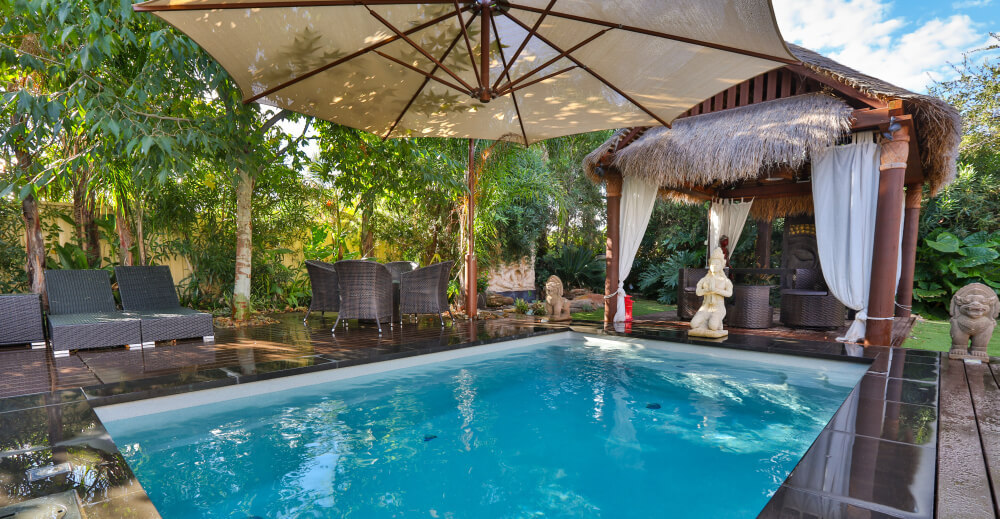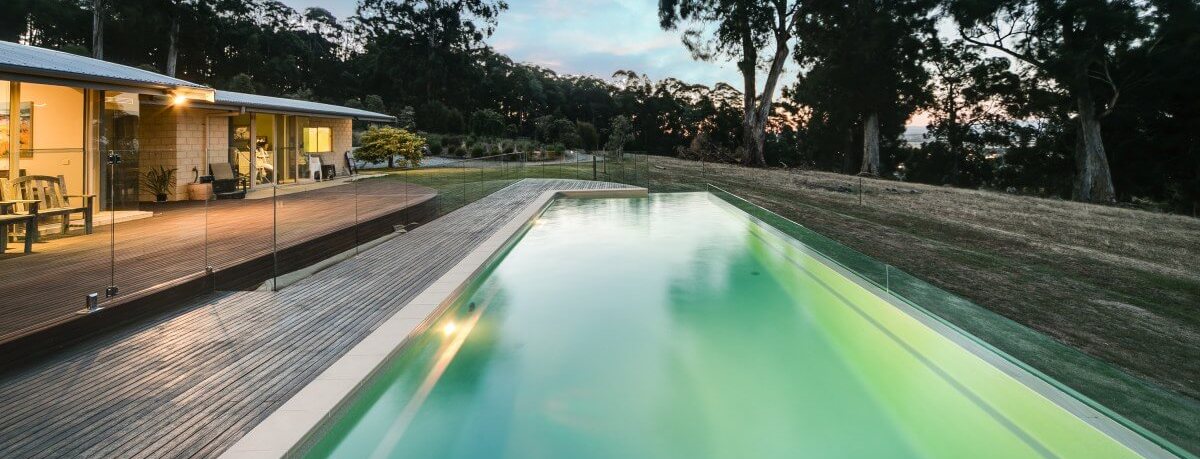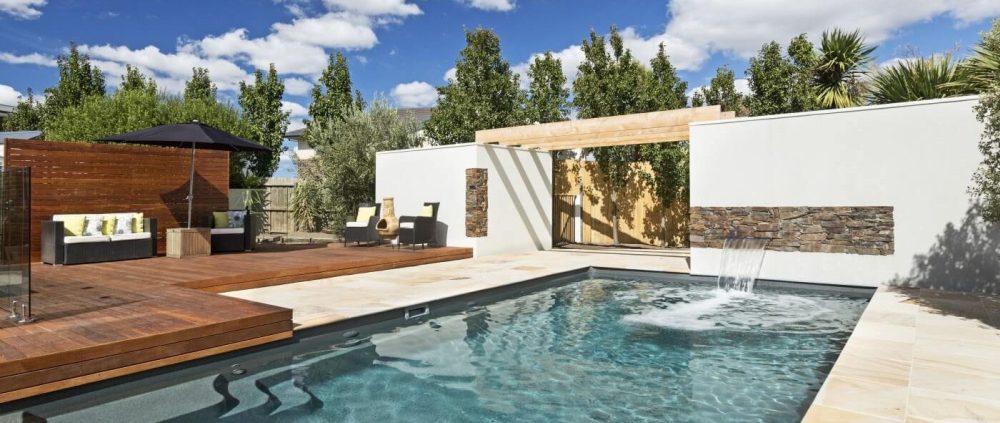The best pools can turn your backyard into an oasis where your family and friends can’t wait to gather. But finding the best swimming pools can present unique challenges, especially if you’ve never had one before. How do you pick the best size, and what elements do you have to consider? Since this can be an expensive investment, you must understand everything that goes into picking the best swimming pools. We’ll outline everything you need to know below.
Different Pool Materials and the Construction Process
Before you get to decide your pool’s shape or size, you have to consider the pool material and construction process involved. There are three main types of pool material you can use, and each one has a different construction process. They include:
Fibreglass
Fibreglass swimming pools come as a large, single shell. A pool installation company will come out and survey your yard. Once you decide on a spot to place your pool, they’ll excavate a hole to match the pool’s unique shape and size. A truck will deliver this fibreglass shell to your home, and the company will lift it into the hole using a crane. Fibreglass pools are ready-made, and this can make it difficult to request a custom design. Most companies that manufacture fibreglass pools have many sizes and models to choose from, and they have pre-formed benches, spas and steps.
Fibreglass is popular for pools because it makes for a rapid pool building process. The interior is very smooth, and this prevents algae from clinging to it. Fibreglass can cost more, and it usually starts to deteriorate after 10 or 15 years.
Concrete with Aggregate or Plaster
If you choose a concrete pool, the pool company will come and excavate the area of your yard where the pool will sit. They’ll frame or line the sides and bottom of the hole with steel rods, and they can turn them into almost any shape you desire. When the company finishes the steel rod placement, they’ll spray either gunite or shotcrete to form the pool shell.
Using this concrete shell with steel bar reinforcement is one of the most popular pool building materials. It has excellent durability, and the concrete itself is very porous. Concrete allows the shell to hold water in, and it is relatively easy to add another coat of plaster years down the line.
Vinyl
Vinyl pools use a plastic or metal frame that the pool company builds above ground, or they can excavate a hole and slip the outer lining inside. The company will place supporting panels or walls made out of aluminium, steel or plastic along the frame before they line in with a thick sheet of vinyl. The bottom is sand, and coping will hold the vinyl’s top-down to create a finished edge.
Vinyl is relatively inexpensive to install, but it does deteriorate in the sun and from exposure to pool chemicals. You can get vinyl liners with UV-protectant coating, but you should only expect your pool to last between 10 to 18 years.
Alternative Finishes
You can choose to have different materials added to your pool’s surface to increase the longevity and give it a sleek look. Popular options include plaster, concrete, stone and tile. Pebble aggregate is gaining popularity because it creates an eye-catching look. When you apply these alternative finish to your pool, they can last between 8 and 12 years.
The Best Pool Shape and Size
Your pool’s shape and size will also play an essential role in how satisfied you are with your pool. Before you decide on a form or size, you want to consider the following:
What is Your Pool’s Purpose?
Will you use your pool a few times a summer and let it sit the other time? If so, you don’t necessarily need a more extensive structure. Maybe you plan to have large family gatherings around your pool. If this is the case, you’d need a more extensive setup. If you plan to use your pool for exercise, you have two options. You can get a larger, more elongated pool to swim laps, or you can get a swim spa where jets keep you in place while you swim, like a treadmill for swimmers.
The deciding factor is the pool’s purpose. You want it to be large enough to accommodate any activities or the number of people who want to use it. If you have three or more in your family, a larger pool is usually the preferred option.
What Are Your Limitations?
You can fantasise about a pool all you want, but the reality is, you’ll most likely have limitations. The cost, time, space and any prefab requirements make up your four most significant limitations.
- Cost – When you consider your pool’s price, size is the most significant factor. Your budget may make you choose between getting a larger pool with sub-par materials or selecting a smaller pool with better materials.
- Time – You’ll spend more time maintaining a bigger pool. If you hire someone to clean it, this won’t be a big deal. However, if you plan to do it yourself, consider how much time you want to invest in cleaning, chemical balancing and maintaining your pool.
- Space – Your pool should fit into your backyard, but it should also leave space for you to move around and host other activities. You’ll need additional space around the pool itself for the deck.
- Prefab Requirements – If you have your heart set on a fibreglass pool or you’re using a kit and doing it yourself; you have limited prefab options. There’s also a maximum size attached to fibreglass pools because they have to travel on trucks.
Who Will Use Your Pool?
Do you plan on having adults only using your pool? If so, having a deeper pool will give you a greater swimming area. If you have kids, having a shallow end or a wading area is an excellent option to consider. Are there any mobility limitations? If there are, maybe you have to have a gentle slope or steps over a traditional ladder. Beach entries usually work best with smaller pools. The goal is to try and plan for the long-term with your pool so you don’t find yourself stuck with something everyone can’t enjoy.
Popular Types of Swimming Pools
Did you know there are over several different kinds of swimmming pools? Along with deciding on a size and shape, considering the pool type is another important factor. At Compass Pools, the different kinds of swimming pools we offer come in small, medium and large sizes, and they include but are not limited to:
- In-Ground – If you have a flat installation site, in-ground pools are a popular option. This type of pool helps to reduce the pool’s final cost.
- Partially Above-Ground – Maybe you want to have your pool’s ledge meet an existing deck. If so, a partially above-ground installation can be a cost-effective and convenient option to consider.
- Above-Ground – Above-ground pools are great for anyone who has a sloping surface or a backyard that isn’t the correct size or shape for a pool.
- Plunge – Smaller yards or spaces can benefit from having an elegant plunge pool. This setup is deep, elegant and perfect for hydrotherapy.
- Family – A family pool gives you enough room for all of your family activities. There are several sizes and options available.
- Lap – Lap pools work well for serious swimmers. It’s a narrow pool that comes with custom length options.
The Best Pool Add-Ons
Pool add-ons are features that you don’t necessarily need for the pool to function, but they can help you customise your pool. They can add luxurious or calming elements to your pool, and the most common pool add-ons include:
- Water Features – Water features are stunning add-ons that create an eye-catching look for any pool. You can pick from different materials, heights and spillways to make them truly unique. You’ll hear the serene and tranquil sound of running water each time you step out to your pool.
- Tanning Ledges – Tanning ledges are shallow areas along the edges of your pool that run about a foot deep. You can request benches or chairs to sit and relax in while you enjoy your pool and the warmth of the sun.
- Spa – A spa is an elevated area of your pool that shares your pool’s water system. The water here is much warmer than the central part, and you can have jets adds to soothe your aches and pains.
- Underwater Lighting – Maybe you want to enjoy your pool at dusk or in the evening hours. Underwater lighting not only looks great, but it helps to make your pool safe to swim in after dark.
- Jets – Jets can give you a soothing element with your pool. You can opt for regular or swim jets if you want something more powerful. Swim jets are ideal for people who wish to exercise in a smaller pool.
- Beach Entry – A beach entry is a sloped entry into your pool. The water starts shallow in one end, and it gradually gets deeper the further into the pool you go.
- Benches – Adding benches into your pool gives you a space to sit and relax. These benches are usually built right into the side of the wall, and you’ll sit in shallow water.
Choosing Vibrant Pool Colours
You don’t have to have boring blue, green or white pools anymore! There are now dozens of dazzling colours you can choose to put on your pool walls. Gel coating gives you dozens of pool colour options and the most popular include:
- Sapphire, Ice Blue or Arctic Marine – Having a light blue or green base with silver, white or deeper blue flakes gives you stunning blue water that has specks of white, light grey and medium blues.
- Royal Blue, Pacific or Atlantic – The dark blue gel coat will turn your pool’s appearance into a very dark blue. This colouring is excellent for day swimming, but it can look almost black at night.
- Beach – The golden brown base comes with flecks of black and lighter brown shades. You’ll enjoy a classic look with crystal-clear water.
- Pearl, Pink Quartz, Quartz or Grey Marble – Some people like the look of quartz because it’s chic. These colours are typically a grey base with white, pink, gold or black speckles, that can look like small rocks.
- Evolution or Viridian – Evolution or Viridian are deeper hues that add an intense and vibrant look to your pool. They help your water sparkle in the sunlight.
Deciding on the Best Filtration System
There are three pool filtration systems you can choose from when you install your pool. Pool filters measure how clean they get your pool in microns. A micron is one-millionth of a metre. To put in perspective, a single strand of human hair is 50 microns while bacteria are 2 microns. The three filter types are cartridge, sand and diatomaceous Earth.
Cartridge Filter
Cartridge filters will work great in small or medium-sized pools. This filter system comes with a tank and a plastic cylinder inside the container. The plastic cylinder comes surrounded by a pleated polyester filter, and there are caps at both ends to hold it in place. Water circulates through the polyester into the tank and out into your pool.
The filter catches any debris that is 10 microns in size or larger. You will have to clean them periodically because they can clog with debris. There is no backwashing, and this filter performs very well at slightly lower speeds.
Sand Filter
Sand filters are for people on a budget who have very little time to maintain their pool’s filtration system. It works well in large pools because it’s challenging to clog. The system sucks pool water through skimmers before forcing it through a large sand tank. The sand traps debris down to 20 microns. This system comes with an external pressure gauge that lets you know when it’s time to backwash the system.
Since this filter doesn’t trap anything below 20 microns, keep up with your pool’s chemistry is critical. If you don’t, you’ll get bacteria in your pool water with you. Sand filters work with #20 silica sand, filter glass and Zeosand.
Diatomaceous Earth
Diatomaceous earth filters catch particles down to .5 microns, but they’re also the most labour-intensive option of the three. This filter system has a tank with grids. The grids have a white powdery substance stuck to them. Crushed fossilised remains make up the white powder substance you see.
This pressure forces the water through the tank and the grid. Anything larger than .5 microns will stick to it. There is a pressure gauge on the outside of the unit that tells you when you need to backflush it. However, you now have to add more diatomaceous earth to your grids. You should mix it until you get a slurry and slowly pour it into your filter system. Don’t swim for at least 12 hours after you backflush it.
Picking a Water System
Finally, you want to decide on a water system for your new pool. There are four broad categories you can check before you make your final choice. They include:
Chlorine
Chlorine pools are the traditional water systems. The chlorine treatment comes in granular form, liquid and tablets. When the chlorine hits the pool water, it sets off a chemical reaction. The chlorine will then oxidise any contaminants in your pool water. Chlorine is a residual sanitiser, and this means it works for weeks after you initially added it to the pool. It’s inexpensive, but it can cause dry skin. You’re not supposed to swim for a few hours after treating your pool.
Salt
Saltwater has been a popular choice for pool water systems since the 1980s, a revival of old-fashioned pools in the days before chlorine. The salt you add to the water effectively kills contaminants while giving your water a “softer” feel. This system is lower maintenance than chlorine, and you don’t get that harsh chemical smell when you treat your pool. The salt is also corrosive to the pool and filtration system, and it can be expensive to replace them once the salt corrodes it away.
Mineral
These pools utilise several different minerals to sanitise the pool and improve the water’s quality. When you have a mineral pool, you’ll have water that contains water-balancing chemicals and sanitiser. However, it also contains salt, magnesium chloride, and potassium chloride. There are health benefits associated with swimming in these minerals, and it makes them popular with pool owners throughout Australia.
Natural
A natural pool comes designed to mimic natural lakes and ponds. These pools use a natural filtration system instead of a chemical one to clean the water. With these pools, there is a smaller pool very close to the main pool, and it’s called a regeneration zone. The pool water filters through either constructed wetlands or a gravel filter. This regeneration zone catches the contaminants and pushes clean water back into the main pool.
UV Sanitation
Although chlorine has always been the go-to choice for pool sanitation, UV is a newer option that is gaining popularity. Ultra Violet technology can kill 99.9% of micro-organisms, algae, fungi, viruses and bacteria in your pool’s water. As the swimming pool water circulates, it’ll trigger the cleaning process and the water will pass through a UV lamp. This light from the UV lamp will kill any organisms, and clean water will flow back into your pool.
Compass Pools Can Help You Pick the Best Swimming Pool
If you’re considering picking out a new pool, Compass Pools can help. We have dozens of styles, sizes, shapes, colours, filtration systems, and materials available. We’re happy to answer your questions and help narrow down your options. You can drop by one of our locations, call us on 1300 667 445 or find your nearest authorised dealer.


























